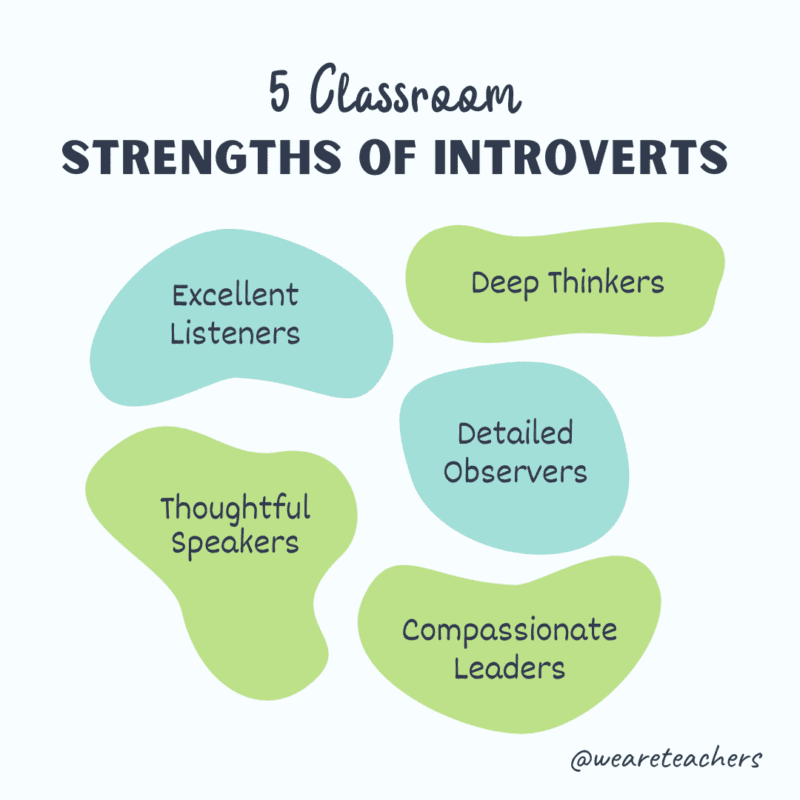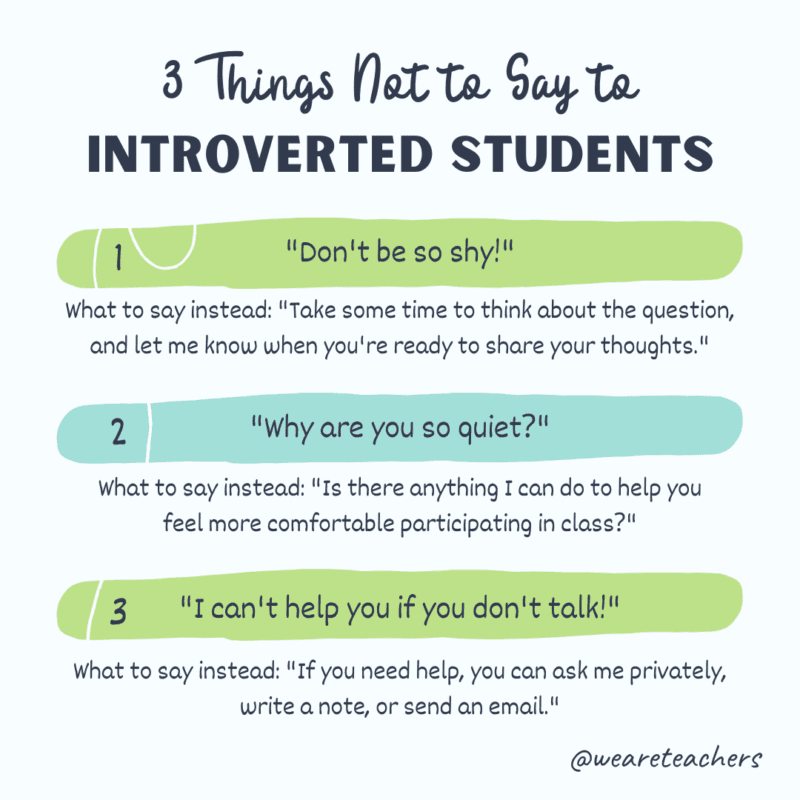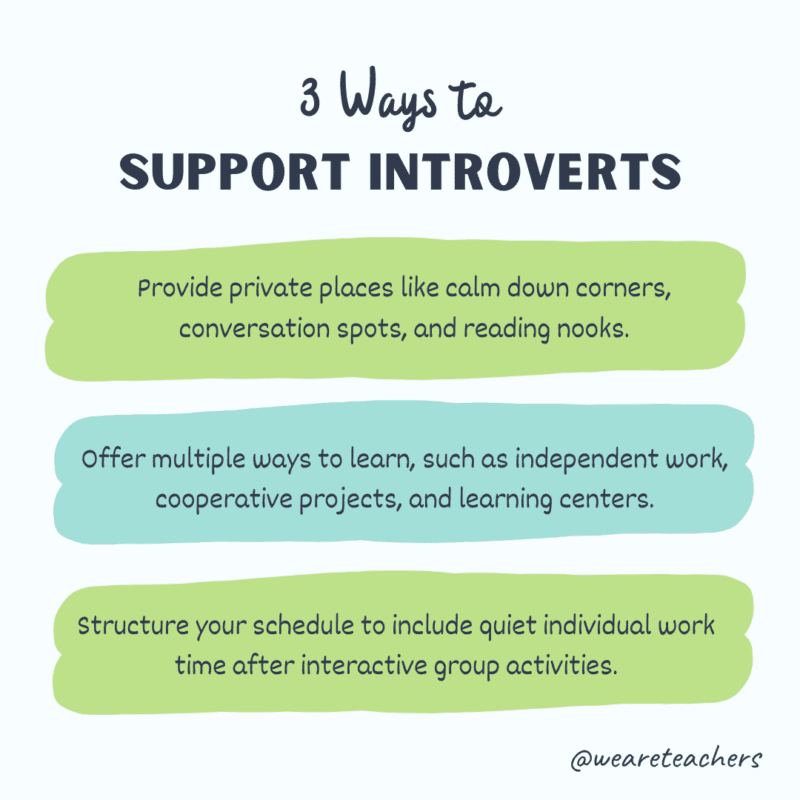Every classroom has introverts and extroverts. You might think it’s easy to tell the difference: extroverts are eager to participate, while introverts are quiet and shy. That’s not necessarily the case, though. Many introverts enjoy time spent with others, but they need time on their own to recover the energy it takes. If you want to support introverts in the classroom, you need to know more about them.
What is an introvert?
The classic explanation is that extroverts are energized by spending time interacting with others, while introverts feel drained by these same interactions. This explains why introverts are more likely to seek out solitude and choose individual tasks over group projects.
One-third to half of your students are likely introverts. Some are easy to identify, while others might surprise you. Some introverts love being in groups and interacting with others. But there’s a limit to how much time they can spend doing so before they desperately need some quiet time to themselves.
Other introverts are quiet and sometimes shy to the point of seeming anti-social. This can cause problems for introverts in the classroom. Many of us associate being gregarious and outgoing with being more engaged in learning. But that may be an unconscious bias against those who are more reserved or don’t stand out in a crowd.
The world tends to cater to extroverts. But introverts are just as likely to be successful in life as extroverts, in all careers and roles. Some of the greatest contributions to society were made by introverts—Rosa Parks, Albert Einstein, Mahatma Gandhi, and Dr. Seuss, to name a few. Educators can support introverts in the classroom by rethinking how we ask them to learn.

10 Ways to Support Introverts in the Classroom
1. Don’t typecast
Don’t confuse being shy with being introverted. Introverts might prefer to pull away from the action, and that can be misread as shyness. And while some introverts are shy and feel anxious in the company of others, that’s not always the case. Introverts withdraw because they’ve received too much stimuli from multiple sources, and they need time alone to re-energize.
The language we use when talking about kids matters. When my eldest son first entered grade school, I had a habit of describing him to teachers and coaches as “quiet” or “sensitive” because they were easy descriptors, both to use and to understand. Without intending to, I was, in effect, pigeonholing him into a type, and in doing so, influencing the way others interacted with him.
2. Draw out their valuable qualities
My son can be quiet and sensitive, but he is also funny, imaginative, observant, kind, and incredibly tuned in to the needs and feelings of others. This past year, not only did he get a speaking part in his fourth grade play, but he got the part of the weird, funny, alien game-show contestant who keeps blurting out answers in a made-up alien language. To everyone’s surprise, including himself, he got the biggest laughs.
There are plenty of benefits to being an introvert. They’re terrific listeners who don’t jump to conclusions. They think before they speak, making thoughtful contributions to conversations. They’re incredibly observant, remaining in the background and taking note of all they see. And they’re compassionate leaders who guide their teams to success without feeling the need to take all the credit. All of these are amazing assets in the classroom.
[contextly_auto_sidebar]
3. Show introverts their strengths
As you recognize their strengths, make sure introverted students see them too. Confident and articulate students receive regular feedback because they participate regularly. Quieter students can fade into the background, so it’s important to find ways to connect. Be sure to show your introverted students that their gifts, while perhaps less attention-getting, are no less appreciated or significant.
Bear in mind that they might not like to be singled out or put on the spot in the middle of class. Subtle communication often works well; eye contact or even a little smile will be enough to let them know that you see them and appreciate their contributions. For more concrete feedback, include handwritten notes on their papers or homework. Send emails to recognize achievements, or just say something quietly as they leave the classroom for lunch or to go home for the day.
4. Provide private spaces
Architects know that the way spaces are designed influences how people behave in them. (It’s known as the concept of “circulation.”) The way people behave in open plazas differs from how people act in more intimate, closed-in terraces, for example.
Same goes for the classroom. A classroom with only large, communal zones will generate lots of large, communal activity. Creating some smaller sequestered nooks encourages a quieter, more low-key atmosphere conducive to reflective thinking and learning. For younger students, try adding a classroom reading nook or calm down corner. Give older students the chance to meet in smaller groups or find solitude with conversation corners or the ability to move their desks around as needed.
5. Make participation about quality, not quantity
There’s an ongoing conversation in schools about grading participation, with teachers falling on both sides of the argument. If you do decide to include it in your formal assessments, be sure you focus on the quality of a students’ comments in class, rather than how often they choose to participate.
I used to tell my high school sophomores and juniors that I wouldn’t call on anyone for at least one full minute, sometimes two, after posing a question. Why? Because I expected them to have put some thought into their answer before sharing it. This worked well for the introverts because they could gather their thoughts free of the immediate pressure to say something. It worked for the extroverts as well because it dissuaded them from blurting out the first thing that popped into their heads.
6. Offer multiple ways to interact
One of the great benefits of being a teacher in the 21st century is the sheer variety of ways to engage with students, from class blogs to social media to a piece of paper and a no. 2 pencil. This means you can provide ways for introverts to shine like never before.
Writing has always been an outlet for introverts in the classroom. Allow students time to write out their thoughts before starting a class conversation. Known as “silent dialogue” or “silent conversation,” this technique allows students to feel more prepared and ready to participate.
Interactive online tools may provide another safe space. Parley lets you compile responses to a discussion prompt, then engage kids in written and verbal feedback. Flipgrid allows students to record their responses when they’re on their own, then share with others. Find more engaging online tools for the classroom here.
7. Offer a buffet of learning options.
The key ingredient for effective engagement across learning styles is variety. Change up your teaching strategies over the course of the day. Follow up a group activity with some focused solo work time. Let students think on a problem independently first, then pair up with a classmate to dissect it further before sharing their ideas with everyone.
When it comes to larger projects, provide a variety of ways for students to share their knowledge. Some might choose to work in groups, staging a debate or acting out a scene from history. Others might prefer to be on their own, writing a traditional essay or making an instructive collage. This builds creativity into the learning process and allows each student to gravitate to the activity that suits their temperament.
Be cautious in how you approach group projects. While we all need to learn to work with others to some extent, not every learning experience needs to be collaborative. Give all students the tools they need to succeed when they work in groups, empowering them to succeed alone or with others.
8. Incorporate quiet time into each day
Collaborative learning is common in classrooms these days, with lots of activity and group work. Introverts may dread group interaction, or they may enjoy it. Either way, they’ll definitely need time to recover from it. Otherwise, they’ll be exhausted and unable to give their full attention to the next item on the docket.
At any age, but especially for younger children, build quiet time for reading, drawing, or meditating into each day. Hold it at the same time each day, so introverts and extroverts alike will recognize this time as part of their routine and benefit from the change of pace.
9. Connect one-on-one to strategize
The breakthrough for me as an introverted child came in the form of my second grade teacher, Mrs. Helbick, inviting me into a separate room to talk about how things were going and how she could help them go better. I had been very anxious up to that point, not knowing how to communicate that I couldn’t focus and needed some space from another child in class, a consummate jokester who went to great lengths to get anyone’s attention.
I recall the immense relief I felt after that conversation. But even more lasting was the boost of confidence she gave me by noticing my predicament and respecting my personality by handling it in a way that would not further embarrass or aggravate me.
In other words, if you want to know the best way to help introverts in your classroom, just ask them! Let them know they’re not in trouble. Then tell them what you’ve noticed about them, and ask how they’re feeling. Together, you can make a plan to support their success.
10. Don’t handhold unnecessarily
As many teachers already know, you can learn as much from failure as success. Schools can provide a safe space to try new things, whether you fail or succeed. Feeling briefly uncomfortable isn’t a good reason not to do something new. So don’t overprotect introverts in the classroom.
Introverts sometimes have to risk stepping out on the limb to hold the spotlight for a moment. Every child at some point needs to learn how to articulate their ideas and also recognize the benefit of learning from others’ perspectives. While the exposure to potential criticism or too much attention can be intimidating for introverted kids, they might just realize the experience is not as bad as they expected it to be.
At the end of the day, we want our students to be happy the way they are. This starts by letting them simply be who they are by paying attention and harnessing the right suite of tools to access each child’s limitless reservoir of potential.

Introvert Resources
Learn more about introverts and extroverts so you can help both succeed in your classroom. These resources can help.
Online
- Quiet Revolution: Resources for Schools
- Introvert, Dear (Award-Winning Community for Introverts)
- Louder Minds (A place for introverts to not meet, quietly, and in a well-planned way)
Books
- Quiet: The Power of Introverts in a World That Can’t Stop Talking (Cain, 2013)
- Quiet Power: The Secret Strengths of Introverted Kids (Cain, 2017)
- Quiet Kids: Help Your Introverted Child Succeed in an Extroverted World (Fonseca, 2013)

How do you support introverts in the classroom? We’d love to hear your ideas in our WeAreTeachers Helpline group on Facebook.
Plus, 11 things that happen when you’re an introverted teacher.


